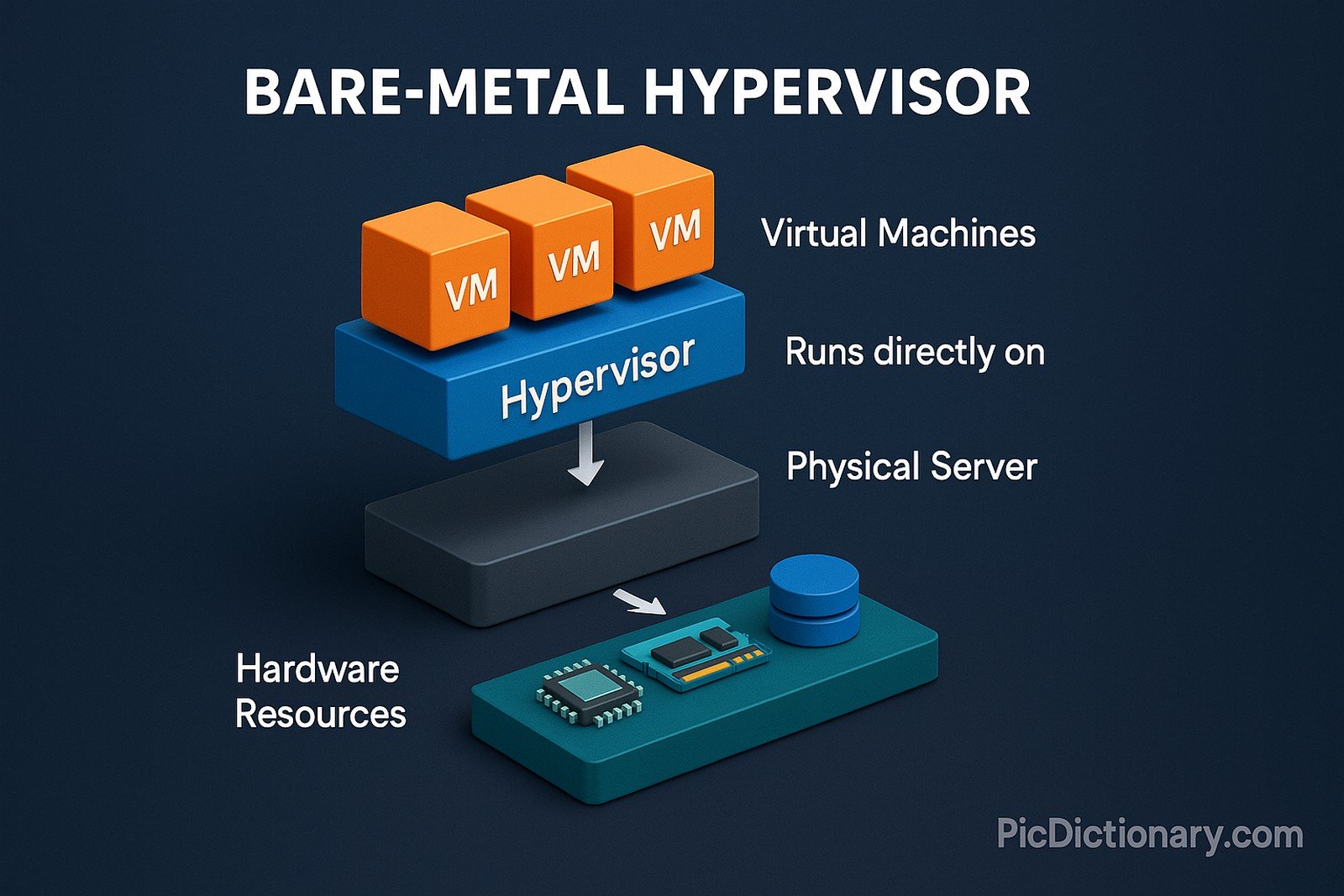Bare-Metal Hypervisor
 (Representational Image | Source: Dall-E)
(Representational Image | Source: Dall-E)
Quick Navigation:
- Bare-Metal Hypervisor Definition
- Bare-Metal Hypervisor Explained Easy
- Bare-Metal Hypervisor Origin
- Bare-Metal Hypervisor Etymology
- Bare-Metal Hypervisor Usage Trends
- Bare-Metal Hypervisor Usage
- Bare-Metal Hypervisor Examples in Context
- Bare-Metal Hypervisor FAQ
- Bare-Metal Hypervisor Related Words
Bare-Metal Hypervisor Definition
A bare-metal hypervisor, also known as a Type 1 hypervisor, is a virtualization technology that runs directly on a physical server’s hardware, bypassing the need for a traditional operating system. It allows multiple virtual machines (VMs) to share hardware resources efficiently. Because it operates at the hardware level, it offers superior performance, security, and resource management compared to hosted hypervisors. Examples include VMware ESXi, Microsoft Hyper-V, and Xen.
Bare-Metal Hypervisor Explained Easy
Imagine you have a toy box that you want to share with your friends, but instead of giving them the whole box, you create smaller compartments inside it. A bare-metal hypervisor is like the divider in the toy box—it splits up the space and ensures everyone gets their fair share of toys without any confusion.
Bare-Metal Hypervisor Origin
The concept of virtualization dates back to the 1960s when IBM developed early time-sharing systems. However, modern bare-metal hypervisors emerged in the late 1990s and early 2000s, driven by the need for more efficient server utilization in data centers and cloud environments.
Bare-Metal Hypervisor Etymology
The term "bare-metal" signifies that the hypervisor runs directly on the hardware without needing an underlying OS, while "hypervisor" comes from "supervisor," meaning a system that oversees and manages multiple virtual machines.
Bare-Metal Hypervisor Usage Trends
With the rise of cloud computing and enterprise data centers, bare-metal hypervisors have become crucial for virtualization. They enable cloud providers like AWS and Google Cloud to allocate resources dynamically and ensure server consolidation. Their adoption is growing as businesses prioritize performance, security, and cost efficiency in virtualization strategies.
Bare-Metal Hypervisor Usage
- Formal/Technical Tagging:
- Virtualization
- Cloud Computing
- Enterprise IT - Typical Collocations:
- "bare-metal hypervisor architecture"
- "deploying a bare-metal hypervisor"
- "bare-metal virtualization performance"
- "Type 1 hypervisor security"
Bare-Metal Hypervisor Examples in Context
- A bare-metal hypervisor is essential for running multiple virtual servers on a single machine in enterprise environments.
- Cloud providers utilize bare-metal hypervisors to offer high-performance, dedicated virtual machines.
- Many businesses migrate from traditional servers to bare-metal hypervisors for better resource efficiency.
Bare-Metal Hypervisor FAQ
- What is a bare-metal hypervisor?
A bare-metal hypervisor is a virtualization layer that runs directly on hardware to manage multiple virtual machines. - How is a bare-metal hypervisor different from a hosted hypervisor?
Unlike hosted hypervisors, which rely on an OS, bare-metal hypervisors run directly on the hardware for better performance and security. - What are some examples of bare-metal hypervisors?
Examples include VMware ESXi, Microsoft Hyper-V, and Xen. - Why do data centers prefer bare-metal hypervisors?
They offer high performance, direct hardware access, and efficient resource allocation. - Can a bare-metal hypervisor run multiple operating systems?
Yes, it allows multiple VMs to run different OSs simultaneously on the same hardware. - Is a bare-metal hypervisor more secure than a hosted hypervisor?
Yes, because it minimizes attack surfaces and does not depend on a general-purpose OS. - What are the performance advantages of bare-metal hypervisors?
They provide lower latency, better resource utilization, and higher efficiency compared to hosted hypervisors. - Are bare-metal hypervisors used in cloud computing?
Yes, cloud providers use them for infrastructure efficiency and virtual server deployment. - How does a bare-metal hypervisor improve scalability?
It allows organizations to scale IT resources dynamically without significant hardware overhead. - Can I install a bare-metal hypervisor on a personal computer?
Yes, but it is primarily designed for enterprise-grade hardware and server environments.

Bare-Metal Hypervisor Related Words
- Categories/Topics:
- Virtualization
- Cloud Infrastructure
- Enterprise Computing
Did you know?
In 2008, NASA used bare-metal hypervisors to virtualize its servers, drastically reducing hardware costs and improving system reliability for space research.
PicDictionary.com is an online dictionary in pictures. If you have questions or suggestions, please reach out to us on WhatsApp or Twitter.Authors | Arjun Vishnu | @ArjunAndVishnu

I am Vishnu. I like AI, Linux, Single Board Computers, and Cloud Computing. I create the web & video content, and I also write for popular websites.
My younger brother, Arjun handles image & video editing. Together, we run a YouTube Channel that's focused on reviewing gadgets and explaining technology.



Comments powered by CComment